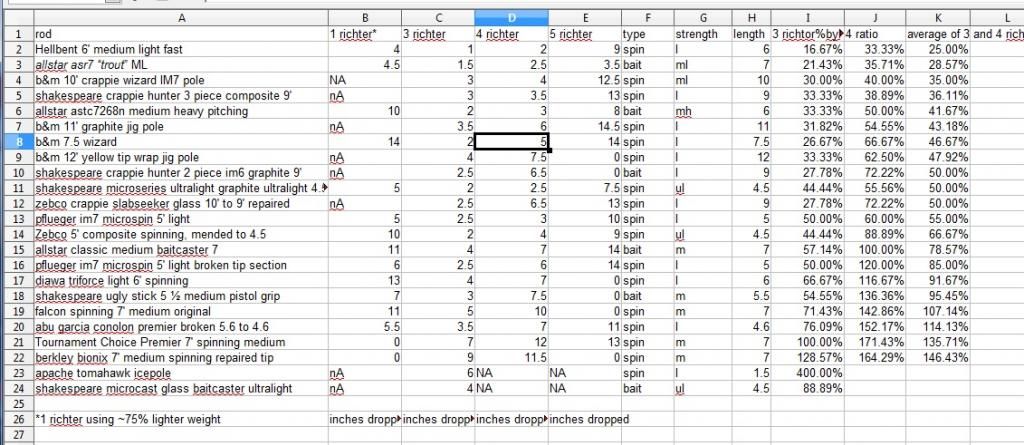That's thinking outside the box
 Likes: 0
Likes: 0
 Thanks: 0
Thanks: 0
 HaHa: 0
HaHa: 0
Given the cold rainy weather I've had some time to fool around with testing rod sensitivity. I've found that how well a fishing rod relays a vibrating cell phone does not really amount to any sort of reliable relationship to how sensitive a rod is to a fish bite.
Other than a vibrating cell phone, I also tried using a jig saw in "slow mo" speed to bump jigs to test sensitivity. However I found that the longer I sat in the cold garage the worse results I got (cold / numb hands). The jig saw test did tell me two things. 1) light fluoro is more sensitive that light braid at least in short lengths and 2) solid plastic baits like BG Baby Shad have a "bounce" that inherently makes them more sensitive that feather jigs or hollow tube jigs when bit.
However I still needed a more objective test. Eventually I found a smart phone app for Andriod called Vibrometer. It's designed to detect earthquakes but it also seems to do a pretty good job detecting fish bites when balanced on a fishing rod set horizontally in a rod holder. To test I used about 2' of light braided line marked at one inch increments with a small swivel as a weight at one end and an even lighter piece of wire as a weight on the other end. By taping the line to the rod through the guides at different lengths and then carefully dropped the weights a specific distances while setting the "earthquake" alarm at various levels, I got good tests on a lot of different rods. The light wire dropping simulated a "peck". For this test I used the one richter scale alarm on the app. The relatively heavier swivel dropping simulated bites and I tested alarms 2-4. The app has a lot of options for tuning the alarms and it has a paid version where the more detailed graphs can be saved. Dropping the weights from the rod tip in a very even fashion still has it's inaccuracies but I simply tested each pole a few dozen times and did not keep any results unless they were repeated at least 3 times in a row. The length of the line needed to trigger the alarm determines the sensitivity of the rod. The shorter the drop, i.e. less force needed to reach the vibration alarm threshold, the more sensitive the pole.
Here are 2 two pics to give a better idea what the testing setup looks like.
Here are the results in a spreadsheet with some averages, sorted roughly by the most sensitive poles first. Some poles were not sensitive enough to test the the low and high ends.

Last edited by Tony from Oak Point; 01-04-2015 at 03:07 AM.
That's thinking outside the box
Wow. You put some time and thought behind this. Nice job and thanks for the post.
Crazy Crappie people , always finding something to do related to our disease . Good job great post
Crappie Attitude
US NAVY Veteran
Find Them Grind Them
Thanks for taking a look! Yep you think it's crazy imagine how my wife feels LOL.
Regarding the results I posted, I've sorted by the average the 2nd and 3rd alarms (light and moderate "bites") and divided by the rod length. For a lot of these rods, I've fished with them for years and the results match up with their fish catching abilities to some degree.
One thing the tests helped me with was showing the results of repaired or broken rod tips. From what I found cheaper glass composite rods can be patched up and then perform as good or better than before. For IM7+ graphite rods when you break the tip the sensitivity is really impacted at least with my amateur repairs.
Another thing I found is that glass composite can be as sensitive as cheaper graphite rods at least when it comes to the initial thump. However the sensitive composite rods tend to snap when I hook up on big catfish.
One detail I didn't record is how long the bite is sustained. I noticed a lot more repeated "beeps" on certain rods. The same bite might last for a second on one pole and 1/10 of a second on another... That's where the high modulus extra fast and more expensive graphite rods don't help you. Dang I better stop thinking about this stuff and do some fishing. :-)
Got around to making a youtube video so thought I'd share here. I've tested two of the same type of rods, a 1 piece and a 2 piece. The 2 piece loses some sensitivity with lighter bites but detects heavier bites about the same. Smart phone app Vibration Meter to test fishing rod sensitivity, 1 piece versus 2 piece - YouTube